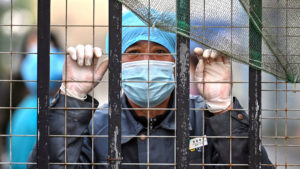In August 2016, a group of public health experts, policymakers and donors met in the Rockefeller Foundation’s Bellagio Conference Center overlooking Lake Como. Their aim was ambitious: to agree on “bold global action” that would mark the “beginning of the end of the pandemic era”. In other words, they hoped to find which viruses might cause the next pandemic, and get a head start on developing vaccines and drugs.
Known as the Global Virome Project, the scheme was officially launched in February 2018. By 2019, it had appointed a board of directors and made the “transition to a legal and operational reality”, according to an email from its head. Yet when a pandemic did break out at the end of that year, instead of leaping into action the Global Virome Project fell silent. It made no announcements, issued no press releases, arranged no public events.
Today, its website is an online zombie. In the greatest pandemic in a century, caused by exactly the sort of novel emerging virus it was designed to predict and prevent, it lists just three publications on its website, one of which is a dead link and the others four and six-years-old. Its “in the news” page lists no article after April 2021. What happened?
Using embassy cables, emails released under freedom of information, and government reports, we have pieced together the history of this wide-ranging international collaborative project and how it vanished just when it was most needed.
The seeds of the project were sown between 2009 and 2019, when the US government funded a big push into virus hunting in wildlife in tropical regions through a programme called PREDICT. When this funding came to an end, the main players got together to seek private and charitable funding to continue the work. These included, from government, Dennis Carrol, director of the Emerging Pandemic Threats Division within the United States Agency for International Development; from academia, Jonna Mazet of the University of California at Davis, who had been director of the PREDICT project; from the non-profit world, Peter Daszak, head of the EcoHealth Alliance, who became treasurer of the new project; and from the private sector, Nathan Wolfe, founder of the DNA database firm Metabiota.
The first meeting of the GVP’s steering committee took place in Beijing in January 2017. George Gao, the incoming head of the Chinese Centers for Disease Control and Prevention, was quick out of the blocks with China’s contribution to the GVP, overseeing the rapid creation of the China National Virome Project. It was formed so quickly that by August 2017 Eddy Rubin, chief scientific officer at Metabiota, wrote: “The project appears to be moving faster than expected with a China component already funded and poised to generate data”.
However, as the GVP was preparing to launch, some scientists had misgivings: did the project even make sense? As two Australian virologists told a reporter for the Atlantic, the work was “unlikely to be informative in predicting the next pandemic”. Spotting the one virus among millions that might cause a pandemic would make finding needles in haystacks look easy. “What you’re trying to predict is likely something that happens maybe once out of tens of billions of encounters, with one virus out of millions of potential viruses. You will lose your fight against the numbers,” said Jemma Geoghan and Ed Holmes.
Other virologists shared their doubts. “Making promises about disease prevention… that cannot be kept will only further undermine trust,” wrote Dr Holmes, in a joint article with Edinburgh University’s Andrew Rambaut and the Scripps Institute’s Kristian Andersen. “I still fail to see at this point how it’s going to better prepare the human race for the next infectious disease that jumps from animals to humans,” wrote Michael Osterholm, the director of the University of Minnesota’s Center for Infectious Diseases Research and Policy.
Nonetheless, ignoring these awkward objections, the GVP team pressed ahead with the project. It was formally launched in February 2018, with an article in Science magazine, authored by Carrol, Daszak, Wolfe, Gao and Mazet with four others. China was poised to play the leading role. “Funding has been identified to support an initial administrative hub, and fieldwork is planned to begin in the first two countries, China and Thailand, during 2018,” the article declared.
In a cable from September 2017, Ping Chen, director of the National Institute of Allergy and Infectious Diseases office in the US embassy in Beijing, had reported that the China part of the project was being funded by grants from the Chinese Academy of Sciences. Shi Zhengli of the Wuhan Institute of Virology (WIV), China’s leading coronavirus virologist, was quoted in the cable as saying: “CAS has already allocated funding for GVP-related research”. Wang Zhengwu, of the Department of International Affairs at CAS, was further quoted as saying “CAS is working on a process and mechanism to support Chinese scientists with backing from the Ministry of Sciences and Technology and The National Natural Science Foundation of China (NSFC) for Global Virome Project type research”.
Sure enough in January 2018, Shi Zhengli received two research grants, one each from NSFC and CAS to study the risk of cross infection of humans by bat-borne SARS-like coronaviruses. It appears the Wuhan Institute had already been entrusted with the main work of the China National Virome Project. In April 2018, confirming the link between this work and the GVP, a US embassy cable noted that “The Wuhan Institute of Virology’s Shi Zhengli… is the forerunner to the Global Virome Project.”
Meanwhile, in March 2018, the EcoHealth Alliance, WIV and others had submitted a joint proposal to DARPA, the Pentagon’s research funding agency. It included a section in which the researchers detailed plans to introduce a genetic sequence called a furin cleavage site into novel SARS-like viruses to increase their ability to infect cells in the laboratory and make them easier to grow. This is the very sequence that has turned up in the virus causing Covid, and in no other SARS-like coronavirus.
The proposal, titled DEFUSE, was turned down by DARPA. Shortly after, however, a “Special Project” was initiated by the CAS with Shi Zhengli in charge for one of the subprojects. The scope largely corresponds and overlaps with the GVP and Project DEFUSE. The goal was to “change the passive response situation of emerging infectious diseases to active monitoring and early warning”, “explore and identify pathogens with potential risks of infecting humans, studying their ability to invade different host cells and their replication ability in different host cells”, and “analyse the key molecules affecting its cross-species infection and its pathogenic mechanism”. In November 2018, at a conference in Bangkok, Hongying Li, the coordinator for the China National Virome Project, showed a slide of the “GVP viral database model”. It included “virus isolation”, the technical term for growing live viruses in the lab.
Some have therefore speculated that the unfunded DEFUSE project could have continued with funding from the CAS. In a recent Vanity Fair article, the prominent Pasteur Institute virologist Simon Wain-Hobson was quoted as saying that “it is possible the WIV would have wanted to copy what it viewed as cutting-edge science”.
The output of the GVP was intended to be a global database of all viruses collected, available to the world. “I believe that our Chinese side can make our great contributions for the development of GVP database system and data portal by the support from China CDC and CAS,” George Gao noted in an email. But there was unease in the West about this. As a State Department cable put it: “Who will own the samples that are collected from many countries? Where will they be analysed? Will all the GVP data be freely available to the public?” Another US embassy cable noted: “Other countries… are skeptical on whether China could remain transparent as a “gatekeeper” for this information.” Eddy Rubin was more blunt: “There is a concern about data sharing if only China takes the lead.”
They were right to be concerned. By 17 July 2019, the Wuhan Institute of Virology had built one of the world’s largest databases of bat and rodent viruses, holding more than 22,000 samples and data entries of pathogens. It has repeatedly refused to share this data with international scientists since the pandemic began. Some of those viruses were collected with funding from US taxpayer dollars, and some samples were collected from countries neighbouring China, such as Laos.
On 12 September 2019, this database was suddenly taken offline. The Institute has not published any details of the SARS-like viruses they were studying after 2016, claiming that people were trying to hack the database. This, of course, makes no sense: sharing data, as intended, makes hacking unnecessary.
Yet far from drawing back because of the data-sharing concerns, in November 2018, Dr Ping Chen of the US Embassy in Beijing sent an email to the National Institutes of Health in the United States detailing proposals for America to share the cost of China’s virus hunting projects. In the version obtained by Judicial Watch under Freedom of Information, most of the email has been redacted, as has most of an attached presentation from July 2019 by the Ecohealth Alliance entitled “Working Towards a China-led Virome project”. What is in these documents, prepared about a year before the pandemic broke out in the city with the most active contribution to the GVP, and caused by a virus of the kind being most actively studied by that project? It would be nice to know.
In a March 2019 article in the journal Biosafety and Health, Dr Gao drew attention to the extra risk of causing a pandemic by studying viruses in the laboratory: “genetic modification of pathogens, which may expand host range as well as increase transmission and virulence, may result in new risks for epidemics.” This was exactly what the Wuhan Institute of Virology was doing to the viruses it was collecting in the wild: working with full-length infectious clones, manipulating their spike genes, creating “chimera” hybrids and testing their infectiousness in human cells and humanised mice.
In August 2019, Dr Gao spoke at length on a podcast, saying that part of the GVP would involve altering viruses in the lab: “[In] GVP you might isolate some virus, you look at it and there is nothing to do with humans, however through adaptation, evolution, you might have some virus adapt to human beings, so as basic scientists you will do all these either in a lab or do the surveillance.”
For some reason, professional journalists have shown little appetite for investigating the GVP since the pandemic began, arguing that it was still just an idea, not yet in operation, which is true outside China. In a recent exchange on Twitter, for instance, Jon Cohen of Science magazine suggested that the GVP had not started as a data-collecting network before the pandemic hit. The independent data analyst Gilles Demaneuf responded that China forging ahead without an agreement about data sharing was a red flag that should call the existence of the GVP into question.
As for the China National Virome Project, almost nothing has been heard of it in the past two years, as if it never existed. The Global Virome Project has also largely evaporated. Both were designed to predict and prevent the next pandemic, a task at which plainly they failed: the research was a year and a half in the making and provided no benefit when the Covid pandemic began. That this work might instead have caused the pandemic is a possibility that must be investigated.
Disclaimer
Some of the posts we share are controversial and we do not necessarily agree with them in the whole extend. Sometimes we agree with the content or part of it but we do not agree with the narration or language. Nevertheless we find them somehow interesting, valuable and/or informative or we share them, because we strongly believe in freedom of speech, free press and journalism. We strongly encourage you to have a critical approach to all the content, do your own research and analysis to build your own opinion.
We would be glad to have your feedback.
Source: UnHerd Read the original article here: https://unherd.com





